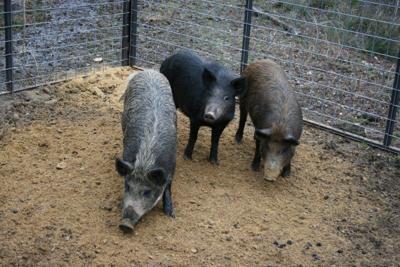African swine fever would be bad enough if it hit a a U.S. farm.
But if the deadly disease were to infect feral hogs, the nation’s swine industry could be in for a long-running nightmare.
Feral hogs are secretive animals that breed prolifically, so they risk becoming a reservoir for the disease. If that happened, they could threaten the health of farmed pigs and jeopardize pork exports for years.
To limit those dangers, federal scientists have adapted existing feral hog control efforts to prepare for an outbreak of the disease.
Staffers from USDA’s Animal and Plant Health Inspection Service described their work in a Sept. 17 webinar.
APHIS launched the National Feral Swine Damage Management Program in 2014 after receiving $20 million from Congress.
Vienna Brown, a biologist with the program, said it has two basic goals — reduce feral swine problems in heavily infested states, and eradicate populations that are new or small.

This map shows feral swine being most widely distributed in the South and California. If African swine fever infects feral pigs, the U.S. swine industry as a whole would be at risk.
With a U.S. population of more than 6 million across 35 states, feral pigs were a festering problem even before African swine fever tore through China’s massive pork industry a few years ago.
That incident raised fears that the disease would spread to the Americas. The disease has not been found in the United States, but it was documented this summer in the Dominican Republic, and the World Organisation for Animal Health announced Sept. 20 that the disease had been confirmed in Haiti.
If African swine fever were to jump to feral swine in the U.S., APHIS hopes to find it through disease surveillance.
Feral pig researchers look for sick animals and unusual deaths. They collect at least 2,800 samples a year to test for diseases of concern, including African swine fever, Brown said.
The agency also has a plan if some of those samples turn up positive.
Within 72 hours, USDA would set up a management area around the dead animal. It would have an infected zone with a radius of 3 km from the carcass, surrounded by a 2-km buffer zone and 5-km surveillance zone.
“There likely would be more than one animal found once ASF is detected in feral swine, and in that case, that 3 kilometers would start from the farthest-out carcass,” said Sarah Bevins, a biologist at USDA’s National Wildlife Research Center.
The infected zone is designed to be three times the average home range of a feral pig. Contact is relatively uncommon for swine that are more than 2 kilometers apart, Bevins said.
Within the control zone, USDA could restrict human access and begin culling feral swine.
Staff would also search the area for dead pigs. Vegetation, rough terrain and scavenging could make carcasses hard to find, but Bevins said this step is important. In studies of wild boars, contact with infected carcasses has been flagged as a major African swine fever transmission route.
Killing the live pigs could be even harder than finding the dead ones, but USDA has a number of tools for the task.
In areas with low swine density, the best options could be trail cameras, drones and tracking dogs. In areas with high density, baiting and trapping could be the best strategies, said Julianna Lenoch, the coordinator of USDA’s National Wildlife Disease Program.
USDA could also turn to snares, decoys, helicopters, sharpshooters and Judas pigs — animals that are fitted with tracking collars to lead hunters to other pigs.
Toxins are not available for feral swine control, but they may be eventually, Lenoch said.
Pigs that are killed would be tested for disease and destroyed.
“We’re preparing for so many different scenarios at the same time,” Lenoch said.
Root of the Problem
While African swine fever has added urgency to control efforts, feral swine have been making nuisances of themselves for quite a while.
Explorers first brought swine to North America in the 1500s, though Brown said feral populations have noticeably taken off in the last couple decades.
Human-related movement is the major cause of this spread. Some pigs also escape from farms and hunting preserves.
Once in the wild, swine readily establish self-sustaining populations, and they can display aggressive behavior.
Most of the U.S.’ feral pigs are in the South, with Texas, Florida, Oklahoma and California having some of the largest populations, Brown said.
In the Northeast, feral swine are present on the Vermont-New Hampshire border, and in Pennsylvania’s Bedford and Fulton counties, USDA documentation shows.
Feral swine cause immense destruction to farm fields through eating, rooting, trampling and wallowing.
“There is almost not a crop that they will not damage,” Brown said.
Swine also tear up golf courses, cemeteries and streamside habitats. They feast on native wildlife and sometimes even lambs and calves.
Feral hogs’ ability to spread a disease to farmed pigs is just one more reason to want them gone.
This story has been updated.
How would you describe the problem of feral hogs in the U.S.?
September 25, 2021



